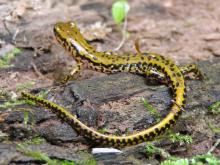Reptiles and Amphibians
Media

Species Types
Scientific Name
Terrapene carolina triunguis
Description
The three-toed box turtle usually has three hind toes. Its high-domed shell usually has a top ridge and is olive or brown with faint yellow or orange lines. Look for it in woodland habitats.
Media

Species Types
Scientific Name
Thamnophis sirtalis sirtalis (eastern gartersnake) and T. s. parietalis (red-sided gartersnake)
Description
The eastern gartersnake and red-sided gartersnake are Missouri's most common gartersnakes. The color is variable, but there are normally three yellowish stripes, one down the back and one on each side. There are narrow black bars between the scales along the upper lip.
Media

Species Types
Scientific Name
Notophthalmus viridescens louisianensis
Description
A small, olive-brown salamander with a fascinating life cycle, the central newt lives in and around woodland ponds and swamps in all but our far northwestern counties.
Media

Species Types
Scientific Name
Eurycea longicauda longicauda (eastern dark-sided salamander) and E. l. melanopleura (dark-sided salamander)
Description
The eastern long-tailed salamander and closely related dark-sided salamander are agile and can escape predators by using their tails for quick jumps. They live in the southern and eastern parts of Missouri.
See Also
About Reptiles and Amphibians in Missouri
Missouri’s herptiles comprise 43 amphibians and 75 reptiles. Amphibians, including salamanders, toads, and frogs, are vertebrate animals that spend at least part of their life cycle in water. They usually have moist skin, lack scales or claws, and are ectothermal (cold-blooded), so they do not produce their own body heat the way birds and mammals do. Reptiles, including turtles, lizards, and snakes, are also vertebrates, and most are ectothermal, but unlike amphibians, reptiles have dry skin with scales, the ones with legs have claws, and they do not have to live part of their lives in water.





















